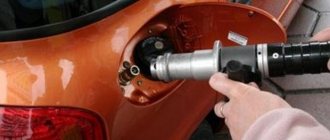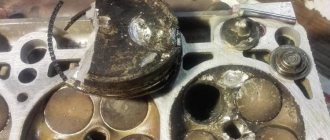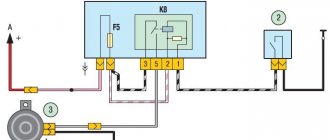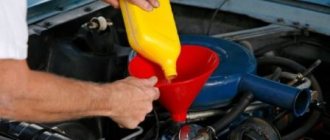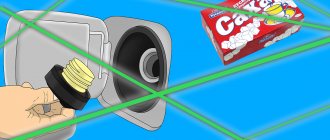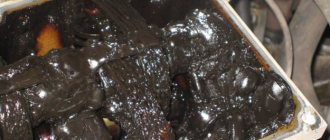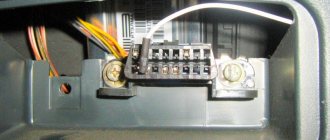Oil filters are one of the most important elements of car maintenance, because motor oil is the “lifeblood” of your vehicle’s engine. Its main purpose is to lubricate the working elements of the engine and remove or stop contaminants through the oil filter. The oil filter, together with the engine oil, work to protect the engine from the entry of polluting particles that can harm the engine and turbocharger, including causing them to fail.
Oil filter elements
- Housing
, which serves to protect the filter elements. - Oil inlet and outlet holes
;
a threaded hole
in the center with which the filter is attached to the engine. - Anti-drainage valve with rubber cover
; it prevents oil from pouring back into the filter when the engine is turned off. - The spring
, together with the anti-drainage valve, prevents oil from pouring into the filter when the engine is not running. - Filter media
, which can be made from synthetic materials, cellulose fibers, polyester or glass. Responsible for cleansing the oil, retaining mechanical impurities. -
steel tube - Safety valve
, which is located on the reverse side opposite the threaded hole. The valve serves to stabilize the pressure. - The filter cover
and
o-ring
are responsible for the tightness of the equipment.
Common oil filter breakdowns
Deterioration in engine performance, black exhaust when accelerating, a drop or increase in oil pressure, the corresponding lamp on the control panel lighting up - all of these may be signs of a malfunctioning oil filter.
In addition to clogging of the filter element, the problem may be related to the loss of elasticity of the anti-drainage valve. This manifests itself in the periodic short-term activation of the controller on the dashboard, most often immediately after starting the engine. This happens because when parked with the engine turned off, oil flows out of the filter housing, and when starting it begins to work without proper lubrication.
The oil filter must be replaced during an oil change. During this line, it manages to get very clogged.
The solution to the problem is simple: you need to replace the oil filter
or a filter element if it is a collapsible model. If you suspect that the filter is not working properly, you cannot delay fixing the problem, because any deterioration in the quality of engine lubrication means accelerated wear and tear, which can lead to much more serious malfunctions and major repairs.
How does an oil filter work?
Before entering the engine, the oil passes through the oil filter. The oil pump supplies oil to the filter, where the crude lubricant passes through the filter element, which traps contaminants. The filter contains primary and secondary media types. The primary ones trap large particles, the secondary ones – small ones (from 5 microns in size). After filtration, the oil is pushed through the central hole into the engine. Over time, more and more contaminants remain on the filter element, so it is fundamentally important to regularly replace the filter.
Why does the oil filter fail?
The filter element becomes clogged with mechanical impurities;
Untimely oil change;
Incorrect selection of engine oil, both for the engine and for the oil filter.
What are the symptoms of a faulty filter?
- Oil leaking from the filter or filter housing.
- Engine overheating.
- The emergency oil pressure lamp does not go out for more than 5 seconds. But it is difficult to identify a malfunction based on this sign, since the lamp can turn off even if the filter is faulty. This happens because when the filter is dirty, the oil can flow through the bypass channel, which allows the oil to circulate without entering the filter. This prevents the engine from starving of oil.
What are the consequences of a malfunction?
- Faulty filters no longer retain mechanical contaminants; accordingly, dirt and harmful impurities enter the engine and turbocharger.
- A malfunctioning filter can cause damage to the engine walls and pistons, causing oil and fumes to escape through the exhaust pipe.
- And finally, a malfunctioning oil filter reduces the vehicle's mileage without damage.
Oil filter device
To better understand this reason, it is worth studying the structure of the oil filter. Most of them consist of a filter element and two valves. The first valve prevents oil from draining into the sump when the engine is not running. The second prevents the lubricating fluid from passing through the filter element during operation of the power unit. This is necessary at very high engine speeds or when the engine has not yet warmed up. Also, running oil bypassing the filter element is required when the latter is heavily clogged. This system does not allow the pressure to decrease. But the lubricant is not cleaned. But the performance of the motor remains normal.
Oil filter/Source:bery.ru
This is how most filters are designed. But there are also those in which the oil will be filtered in any case. They have an additional filtration element in front of the bypass valve. But over time it becomes clogged. And then the oil can't pass through it. As a result, the pressure decreases and the warning light on the instrument panel lights up. Sometimes contamination of this element occurs long before the next oil change. If you continue to drive like this, the power unit may fail.
Oil filter in turbocharger operation
We all know that oil plays a key role in the long-term operation of a turbocharger, and often it is oil (oil contamination, untimely replacement, etc.) that causes turbocharger failure. Dirty oil kills the turbocharger, it affects the turbine much more than any other part of the diesel engine. Under extreme loads, the rotation speed of the turbine shaft can be 250 rpm, and at this time, engine oil is the only thing that cools the turbine, gives it lubrication and prevents metal parts from rubbing against each other. That's why it's vital to keep your oil clean and your oil filter in good working order—the best protection for your turbocharger and engine. The turbocharger has to work under difficult conditions: at high speeds and at high temperatures, and clean filtered oil will protect the turbine from wear.
As mentioned above, a lot of contaminants remain on the filter element that the system cannot remove on its own, so do not forget to check the cleanliness of the filter from time to time and change it if necessary. An oil filter will extend the life of your turbocharger and engine.
22.06.2018
Malfunctions of the oil pump will inevitably lead to disruptions in the lubrication system of the internal combustion engine. serves to ensure pressure in the oil supply system. Symptoms of malfunctions and interruptions in the operation of the device indicate serious problems that require immediate attention.
Types of oil filters
Currently common in the automotive industry:
- full flow
- partial-flow
- combination filters
Full flow filters have the simplest design and immediately pass all the oil coming from the oil pump through the filter block, which is then supplied to all engine lubrication points. This oil filter
operates on the basis of a bypass valve that regulates the pressure in the lubrication system. If the oil pressure exceeds the permissible value, it is reduced by the filter bypass valve. This is a certain disadvantage of this design, since when the filter is clogged, the oil flow slows down, the internal pressure increases, the bypass valve opens and allows contaminated oil into the system. The bypass valve, on the one hand, prevents immediate engine breakdown due to cessation of lubrication, and on the other hand, it allows dirty oil to circulate, which is why the condition of the filter must be monitored very carefully.
A partial flow engine oil filter cleans the oil longer than a full flow one. In systems where it is used, the oil is purified gradually, circulating in two circuits at once: direct - from the pump to the friction zones, and purification - from the pump, through the filter and to the friction zones. During the circulation process, the oils of different circuits are mixed, which ensures the cleaning of the engine lubricant as a whole. Such systems are capable of maintaining oil in good condition over a long period. Their significant advantage is that even with a clogged filter and broken valves, the oil flow will not stop and the engine will run.
Combined systems are created using technologies from both previous types. Here, the oil filter device guarantees maximum quality of oil filtration and the longest period of its use.
Main signs of a malfunctioning oil pump
The vehicle's lubrication system ensures stable and durable operation of the main engine components. The engine contains many parts that experience strong friction during operation and quickly wear out without constant lubrication.
Many motorists are interested in the question - how to recognize a faulty oil pump? If the oil supply is insufficient, a so-called “oil starvation” occurs. It can lead to engine failure, resulting in a complex and expensive overhaul of the power unit.
One of the first signs that the oil pump is damaged will be a light on the instrument panel. If this happens, you should check the pressure in the oil supply system, and also pay attention to the oil consumption.
- Reduced oil pressure in the system.
- Noticeable increase in oil consumption.
If the pressure in the device decreases, the car cannot be used until the cause of the problem is determined and the car is repaired.
There are several main reasons for system malfunctions. Here are some of them.
Replacement frequency
No oil filter has outstanding durability.
Exceeding the service life threatens to compromise the intensity and quality of cleaning. The oil is not cleaned and remains dirty, which accelerates wear of engine parts.
Related terms
The oil that we pour into the engine wears out on its own, even when the car sits quietly in the garage - it oxidizes. Moreover, oil wear is inevitable during active engine operation under heavy loads. One of the big tests for an engine can be oil starvation - we’ll find out how to avoid it, signs and consequences, and how to determine oil starvation right now.
Causes of oil pump failure
- drop in oil level in the engine crankcase;
- damage to pressure monitoring devices;
- use of low-quality oil;
- using the wrong oil for the vehicle;
- failure of lubrication or safety valves;
- oil filter contamination;
- clogged oil receiver and blockage in the pump housing.
The blockage may be due to a dirty engine crankcase. To eliminate this problem, it is enough to remove the crankcase (after draining the oil) and clean the pan of dirt.
Malfunctions in the oil pump can manifest themselves in the form of various problems. They can be determined during diagnostics. The main possible problems with the mechanism are listed below.
Oil pump malfunctions:
- gasket damage;
- oil filter clogged;
- the filter is not secured securely;
- increased wear of main parts;
- failure of the pressure reducing valve.
The oil pump in a car has a fairly long service life and breaks down infrequently. Most often, breakdowns are caused by improper operation of the car engine, poor-quality repairs or the use of low-quality oil. A decrease in oil pressure and an increase in its consumption are the main signs of a malfunction of the oil pump, after detection of which the system should be immediately diagnosed and the cause of the failure eliminated.
Externally, the oil filter looks as simple as the task assigned to it. And this task is simpler than a steamed turnip: to clean from dirt, which is a set of foreign inclusions that have penetrated into the engine from the outside along with air and fuel, wear products of rubbing engine parts, as well as soot, coke, and mucus-like oil decomposition products formed inside the engine.
Nothing else is required from the filter, so if you look into it through the threaded hole in the bottom, you can expect to see a paper filter element inside that traps dirt that appears in the oil. The better the dirt is filtered out, the longer the engine will last until it eventually becomes a victim of natural wear and tear.
However, if you disassemble the filter into individual components, it turns out that in addition to the filter element, there are some other parts in it.
This is a bypass valve. It owes its appearance in the filter design to the fact that as dirt accumulates in the filter element, the resistance to oil flow through the oil filter increases. Because of this, situations are possible when the filter actually turns into a plug, preventing the flow of oil to the rubbing parts. The bypass valve is precisely designed to prevent oil starvation in the bearings of the crankshaft, camshaft, and turbocharger cartridge, which are lubricated under high pressure, and their subsequent jamming.
As soon as the filter's resistance to oil flow becomes excessive, the valve opens, after which the oil flows past the filter element to the parts lubricated under pressure. However, another problem arises - the oil is supplied unrefined. To put it simply, the lubrication system begins to work as if there was no filter at all, with all the ensuing consequences for the service life of the engine. The question arises: when does the bypass valve actually open? This question was asked by our reader who sent a letter to the editor of the site, excerpts from which we present below:
“I came to the conclusion that in order to detect the moment the bypass valve is activated, you can use a button with normally closed contacts and a control light. We connect one contact of the button to the filter housing, and take the other out. When the valve is closed, it presses the button. The contacts are open - the light does not light. But when the valve opens, the button is pressed and the light comes on.
Prepared the filter. The button was soldered into double-sided PCB. I drilled a hole into which I inserted a textolite insert with a button. It took some time to adjust the height of the button. While I was adjusting it, the engine oil, according to the indicator on the instrument panel, managed to warm up to 50 degrees. With such warming up, the control light signaled that the bypass valve was activated only at 6000 rpm and immediately went out. When the engine warmed up completely, the light did not come on at all.
The next morning I returned to the car. The alcohol thermometer on the wall in the garage showed 2 degrees below zero. I started the engine and the light didn’t even blink. I add speed to 2500 - there it is, it lights up! I drop the revs to 2000 and it goes out. So, everything works as it should! It remains to be seen how long the filter will last.
The first results appeared after a run of 1000 km. I attached a temperature sensor from a multimeter to the filter with electrical tape. The filter temperature is 4 degrees below zero. Exactly the same amount was on the thermometer in the garage. I start it up and the light comes on immediately. This is understandable: the oil is thick in the cold, the filter is already slightly clogged with dirt. He has no choice but to open the valve and let the dirty oil in directly. I wait and watch the multimeter. The oil temperature has already reached 15 degrees Celsius, and the light still does not go out!
Maybe the valve is stuck? I turn off the engine and the light goes out. I start it up and it lights up. So everything works. Only at an oil temperature of plus 30 did the light go out at idle. At the same time, the coolant temperature has already risen to plus 55. I increase the speed to 2500 - the light comes on, slowly drop it to 1300 - it goes out. I didn't wait any longer. But there is already something to compare: with the new oil and filter it was the same, only then it was minus 2, and now the same result at plus 30. In any case, after complete warming up in normal mode, the valve does not open, which means the oil filtered. What else do you need?
Subsequently, the situation only worsened. At 2500 km, when starting, the light comes on and does not go out at all. If, after a good warm-up, you turn it off, and the bypass valve naturally closes, and then start it, the light does not light up. I give the rpms under 3000 - it lights up and doesn’t go out again. This means that the valve is not closed and allows unrefined oil into the engine lubrication system.
In addition to experiments on my personal car, I soldered the same buttons into the filters of my friends’ cars. That is, the operation of the bypass valve and how long the oil filter does its job have been tested on different machines, with different oils and different filters. The result is the same: 2500 km is the ceiling for the filter. Once, however, they reached 3000 km. Maybe the fact that the car made a couple of long-distance flights played a role.
I would also like to say a few words about the check valve. It is supposedly designed to prevent oil from leaking out of the filter when the engine is turned off. The idea is good, but only this valve holds the oil, which is in the outer circuit, and for some reason the manufacturers do not take into account the fact that it can simply seep through the paper and drain through the inner tube! How long it will take for this to happen is hard to say, but it must flow out! The best option is when the filter is installed bottom up, such a filter does not need a check valve at all. In other cases, only frequent starting or a clogged filter can help, when dirt does not allow oil to seep through the paper. If this is not the case, in the morning we start our cars with empty filters.”
From the editor
The recommended frequency of replacing engine oil and oil filter in Belarusian operating conditions is 12-15 thousand km for gasoline engines, 8-10 thousand km for diesel engines. Judging by the results of the experiment carried out by our reader, only the first 2.5-3 thousand km after replacement does the filter cope with its duties of cleaning the oil from dirt, and then it becomes less and less useful, if it remains at all.
Choose motor oil for your car from!
A puddle of oil under the car will make any driver worry. Every time I go out and have a free minute, I try to warm up the engine at the garage and only then move. An oil leak in the area of the oil filter is a serious thing, even if you have complete confidence in the serviceability of the oil pump and filter, it is worth delving deeper into the problem. It's not even about what squeezed the oil through the oil filter. It squeezed out - that's understandable. The problem is why, for what reasons, high pressure occurs, which squeezes the oil out from under the oil filter.
In most cases, the problem is solved by tightening the filter housing more firmly, sometimes even using improvised tools. Most knowledgeable motorists consider the following to be the culprits of the incident:
- incorrectly selected lubricant viscosity;
- malfunction of the pressure reducing or bypass valve;
- low-quality product with a weak and soft body;
- loosely twisted oil filter housing on the fitting;
- Poor quality o-ring rubber seal.
In pursuit of engine life
Before making a diagnosis as to why the lubricant was squeezed out, it is worth correctly assessing the conditions under which the problem occurred. Let's take into account the temperature and quality of materials. We will not consider the fourth position; in this case, the oil leak from under the oil filter was the result of inexperience rather than dishonesty. You only need to tighten it by hand, making sure to lubricate the sealing gasket with oil. If you tighten the filter using a tool - a wrench or a special puller, the rubber may be deformed too much, and the edge of the filter cover will come into contact with the mounting flange. In this case, the tightness of the connection will remain in question and the lubricant can be squeezed out at any time.
The first typical mistake that causes oil to squeeze out through the oil filter is high speed in cold weather. Ordinary mineral oil thickens at low temperatures to the state of jelly or grease. A gear pump can raise oil pressure up to 10 bar and squeeze it out through any gap, but it’s difficult through a microsponge or filter paper, and the cold oil flow is very reluctant to pass through the bypass valve.
Often such experiments lead not only to the lubricant being squeezed out from under the oil filter, but also to damage to the hardened seals on the crankshaft. In the latter case, repairs will cost several times more than a conventional device replacement.
Advice! If you often drive in severe frosts, switch to 0W20 viscosity oil and an oil filter with a spring bypass mechanism. The rubber flapper valve works much worse in severe frost. Also, be sure to check the operation of the spring valve before installation. Often the reason that grease is squeezed onto the road is a jammed valve.
If the filter element is designed for light, low-viscosity synthetic oil, then its design will have a reduced number of inlet holes, and they will be of smaller diameter. Due to the high viscosity of cold mineral water, the main flow of oil is not able to be squeezed out through small holes. As a result, the housing was swollen or the oil filter gasket was pressed out.
The second, most common mistake is the inappropriate use of various types of revilitants that offer quick restoration of rubbing surfaces. In most cases, all the debris added to the oil ends up in the filter element and bypass valve, blocking the flow and, as a result, forcing the lubricant through the seal.
Do not use traditional recipes for flushing the lubrication system - mixtures of kerosene and oil, gasoline and oil, kerosene with acetone and benzene. At best, such an explosive mixture will dissolve sediment in the drain channels and in the engine sump. Attempts to start the engine and idle result in light and low-viscosity fluid leaking and squeezing out through the oil seals and the housing seal. Residues from such flushing can lead to swelling and deformation of all gaskets in the lubrication system.
A similar effect is possible from high-viscosity motor oil. Advertising for such products promises normal oil pressure for worn engines. In hot weather, this oil actually works better, but with the arrival of cold weather it can easily squeeze out any rubber bands from under the filter. Moreover, oil filters are not designed for such innovations, and as a result, oil leaks from the oil filter.
A situation where the lubricant is squeezed out from under the oil filter results in:
- savings on flushing the oil system with special liquids;
- the bad habit of not changing the oil, but adding it as it decreases;
- use purified surrogates instead of normal high-quality oil.
If flushing was not used when changing the oil, as an option, you can pre-install and use a cheap simple filter. After a hundred kilometers, most of the dirt will be deposited on such a filter, and it will need to be replaced with a new high-quality version. But such a recipe is only allowed when using high-quality oil with good detergent additives.
The habit of adding oil instead of replacing it is typical for owners of old, worn-out engines. The amount of sludge deposits and varnish films compensates for metal wear in rubbing surfaces. In such cases, the filter may leak after a large amount of gasoline and water gets into the engine sump, even in relatively mild frost.
The high cost of good motor oil has led to the emergence of special cleaning technologies that make it possible to clarify used oil, increase its viscosity and remove foreign odors. But even after the cleaning procedure, such a lubricant contains a significant amount of hydrocarbons, which easily turn into varnish films and sludge, tightly clogging the filter cartridge.
Using fake low quality oil filters
The problem of counterfeit products is especially relevant during the winter period of operation or the engine break-in period. First of all, counterfeits use low-quality materials for the filter layer, rubber seal and bypass valve elements.
One of the noticed defects that catches the eye after the oil filter has been squeezed out is a violation of the geometry of the box:
- swollen sides of the body;
- extruding the cover with a threaded bushing “into the dome”;
- deformation and extrusion of the valve rubber.
You can easily determine the quality of the oil filter by blowing into the inlet hole. In a fake, the weak valve petal will easily open; in the original product, it will not be possible to overcome the valve resistance by simply exhaling. In addition, it is worth paying attention to the condition of the filter “accordion” and the rubber ring of the seal.
If the edges of the paper are folded unevenly or are unevenly colored, or metal burrs are visible inside the center core, this is a fake. It is worth paying special attention to the elastic band. The height of the ring above the surface of the lid should not be more than 0.8 mm; the material is quite elastic and rigid, but not hard. Soft rubber will not withstand high pressure - it will instantly deform and be squeezed out of the groove.
A characteristic feature of VAZ cars is the tendency for the pressure relief valve on the engine oil pump to jam. This often happens due to dirt getting into the lubricant or engine overheating. Therefore, if there are repeated episodes of lubricant leakage, do not puzzle over why the oil filter is being squeezed out, but clean and adjust the operation of the pump.
Attention! One of the reasons why oil flows from under the oil filter may be a violation of the perpendicularity of the position of the central fitting onto which the filter is screwed. After installation, the filter housing and cover do not adhere to the flange surface evenly and evenly, but at a barely noticeable angle. In this case, the rubber seal will not provide the necessary tightness, and lubricant will leak under any conditions on any filter. The cause of such a defect may be impacts on the filter housing or excessive force during removal.
Video about what to do if the oil filter gasket is pressed out:
The oil filter plays an important role in the lubrication system. The oil, circulating in the engine vessels, washes away wear products and carbon deposits. The filter, in turn, retains various mechanical particles, allowing clean oil to pass through. Thanks to the operation of the cleaning element, solid dirt components do not slip between the rubbing parts of the engines, which significantly contributes to its long service life.
Oil filter replacement intervals
If you want to keep your engine safe and sound, we advise you to regularly change the oil filter. The oil filter is the main protection of the crankshaft and moving engine parts. If its operation is unstable, the car’s engine quickly fails.
If you have neglected the recommendations for replacing the oil filter for a long time, then be sure that such an amount of dirt has accumulated in it that it hardly passes the oil or, in general, it does not pass at all.
The last assumption is exaggerated, since the design of oil filters provides a bypass valve, which means oil circulation in any case, even when the filter is clogged. But you can imagine what kind of oil it will be. Therefore, do not bring the situation to a critical point.
Various automobile concerns and oil filter manufacturers recommend different intervals for changing cleaning components. As a rule, these periods are very short, since manufacturers care about their reputation and therefore recommend frequent replacement of filters.
Experts advise replacing it every 8-12 thousand km, which coincides with the timing of engine oil changes. However, if you have any doubts about the purity of the oil or any bad signs appear, you can replace the filter ahead of schedule. The benefits of timely replacement are obvious, judge for yourself: if an engine can be purchased from $2000, then a new filter will cost you $10-20. Therefore, do not leave replacing the air filter for later.
How to choose a good filter: video
By changing the oil filter in a timely manner, you can improve the performance of your car engine. The procedure should be performed strictly in accordance with the technical requirements. Any motorist can replace this part, but if there is no time, it is better to contact a service station - where the work will certainly be done quickly and efficiently.
- Author: Alexander
Rate this article: (2 votes, average: 5 out of 5)
Signs of a clogged oil filter
If the oil filter has become unusable, then you most likely will not find out about it until you contact a car mechanic or remove it yourself. It's all about its bypass valve, which was already written about above. If the filter is clogged, it will allow unrefined oil to pass through, which is still better than not having it at all. But not everything is as ambiguous as it might seem at first glance. First, listen to your “horse”.
- Overheat.
When moving engine parts rub against each other without sufficient lubricant, excessive heat is generated. Due to this factor, the engine mechanism begins to wear out faster, which causes additional stress on the cooling system. In addition, unfiltered contaminants form sediment and begin to be deposited in the engine, which causes a decrease in thermal conductivity. The result of this is engine overheating. Normal engine operation takes place at a temperature of no higher than 80-100 ° C; if this indicator is increased, this indicates contamination of the oil filter. - A leak.
A faulty or clogged filter does not respond well to changes in temperature conditions inside the motor. Faulty oil filters can rupture or burst, causing oil to leak. Therefore, if you notice any fluid leaking from your car, contact a mechanic immediately.
Where is the oil filter located?
If you have come to the conclusion that you can handle replacing the oil filter yourself, then before starting the operation you must clearly understand the entire sequence of your actions.
- Find the oil filter. It is located at the bottom of the engine on a sump. (see photo).
- Next, before the replacement procedure itself, drain the oil. It must be drained when the engine is hot, for example, after a trip. If the car is parked for a long time, then start the engine so that it warms up to operating temperature.
- Keep in mind that the brand of oil poured into the engine must be the same as what it was before the replacement. If you decide to change the brand of oil, then flush the lubrication system with flushing oil or oil used subsequently.
- Flushing involves draining the used oil and then filling in new oil to the level of the lower mark. Old oil should not be poured onto the ground; place a previously prepared container. After draining the used oil, start the engine and let it idle for 10 minutes. Next, you can change the oil filter. After replacing it, fill in new oil to the required level - the upper mark on the dipstick.
After this procedure, prepare all the necessary tools and begin replacing the oil filter.
How to change the oil filter
This procedure, if combined with replacing the engine fluid, is the easiest way to increase the service life of the engine. If the time for mileage has not yet come, then this should be done once every 6 months. Algorithm of actions when changing the oil and filter:
- Warm up the engine for a couple of minutes at idle speed, turn it off, unscrew the oil filler cap, place a container under the crankcase and drain the oil (this can be done immediately after the trip). If you are not going to use the flushing compound, then screw the bolt (or nut, depending on the car model) into place.
- Remove the old filter using a dry cloth or gloves. If this cannot be done, you will have to find a special puller that fits around the body of the product. Don't forget to place a small container down: oil will flow out of the filter. Pay attention to the gasket: it may stick to the engine - it needs to be removed.
- Take the new filter and lubricate the rubber o-ring with fresh engine fluid. Screw the product into place by hand.
- Fill in new oil (if you intended to do so) and close the cap under the hood.
- Start the engine and make sure the oil pressure warning light goes out.
At the final stage, place a clean cardboard or newspaper under the motor. The absence of traces of oil will confirm that the filter is installed correctly.
Oil filter replacement tools
- New filter.
The price of the product depends on the preferences of the chosen brand of oil. Experts recommend marking the oil as 5w30. - Container for draining used oil
. Choose a container that is shallow but fairly wide to minimize the possibility of oil spilling on the ground. - Latex gloves.
Designed to protect hands from burns that can be caused by hot oil when unscrewing the oil pan drain plug. - Gate.
Needed when the drain plug is too tight. - Replaceable socket head.
Used in conjunction with a collar, the size must match the drain plug. - Band wrench.
If access to the full flow oil filter is limited, it will allow you to remove it without any obstruction. - Socket wrench.
It is fixed at the end of the filter and then rotates using a ratchet drive or gate. The dimensions must match the filter housing. - Rags and old newspapers.
Leading manufacturers
The best oil filters , according to many car owners, are produced by the following companies:
- Mann is one of the most popular brands today. The German company produces filters for many large automobile concerns in Europe. The company is distinguished by a very small number of defects, thanks to multi-stage quality control management.
- Union is a well-known manufacturer from Japan. It supplies its products to many automakers in Asia. Produces high quality filters. Possesses an international quality certificate ISO-9002.
- SCT is a German brand. Cooperates with most car factories in the CIS countries, including Russian manufacturers. An excellent option in terms of price and quality.
Video review of oil filters
Step-by-step instructions for replacing the oil filter
- To have free access to the oil filter and oil pan, lift the car with a winch or drive it onto an overpass. You can also use a jack and supports.
Attention! Do not work under a vehicle supported only by the bumper or supported by a jack alone.
- Lie under the vehicle and locate the oil pan drain plug and engine oil filter. Please note that the exhaust system components will remain hot throughout the replacement procedure. Therefore, if your hand skin is unprotected, avoid contact with heated surfaces.
- So, after making sure that the car is horizontal on a lift or supports, warm up the engine to operating temperature. Hot oil is not as viscous, so it washes out sediment and sludge better. Then turn off the engine and remove the filler cap.
- After this, get under the car again and place a container for draining the oil under the oil pan. Taking precautions, remove the drain plug from the bottom of the oil pan.
- Allow the oil to flow freely into the canister, adjusting its location as the pressure of the stream weakens. Check the leaked oil for the presence of metal filings.
- After all the oil has drained, be sure to wipe the drain plug with a clean rag.
- Wipe the surface of the pan around the drain neck, screw the plug into place and tighten it firmly with a wrench (preferably a torque wrench to avoid stripping the threads).
- Move the drain container under the oil filter.
- Using a special wrench, loosen the oil filter clamp. During the twisting process, the filter housing may be damaged, which does not matter, since you are definitely replacing it with a new one. The following advice will help you when unscrewing the oil filter. In order to remove the filter you need to use a special key. If you do not have such a key or a similar puller, you need to pierce the filter housing with a screwdriver and unscrew it, using it as a lever. The filter should be punched as close to the bottom as possible to prevent damage to the fitting. In addition to this method, you can unscrew the filter with both hands, after wrapping it with coarse sandpaper.
- After finally unscrewing the filter from the block, make sure that the rubber seal has been removed along with the filter; if not, then carefully separate it from the walls of the engine block.
- Use a clean cloth to wipe the seating surface of the filter on the unit. If the old rubber gasket still remains on the engine, use a scraper.
- Next, you need to make sure that the new filter matches the old cleaning element in size. If everything is in order, then your next action will be to lubricate the sealing gasket of the new filter with fresh engine oil. You can then screw the new filter into the engine, following the direction of rotation indicated by the arrow on the filter housing. When tightening the oil filter, do not use any wrenches to avoid damaging the gasket. When the filter is pressed against the surface of the block by the gasket, tighten it another ¾ turn.
- Next, you need to remove all the tools from under the car and lower it to the ground.
- After this, you need to find the filler hole for the engine oil and remove the cap from it. Next, take a funnel and pour fresh oil into the receiving neck of the engine. After pouring about 3 liters of lubricant, you need to wait a few minutes for the oil to drain into the pan, and then check its level using the dipstick. If the level is above the lower mark, start the engine to circulate new oil.
- When the engine has been running for a minute, you need to turn it off again and look under the bottom of the car, checking for leaks through the drain plug and full-flow filter. If necessary, tighten the fasteners to prevent leaks.
- The oil filter is filled with fresh lubricant in one minute. After this time, it is necessary to re-check the oil level. If it is not enough, then add a little more, bringing the level to the upper mark on the dipstick blade (check again a few minutes after turning off the engine - during this time the oil will completely drain into the oil pan).
- The first few trips after changing the engine oil, measure its level as often as possible.
- The drained used oil is no good for anything, so it must be handed over to a special collection point. It should not be poured onto the ground or down a drain, as it is very dangerous for the environment.



